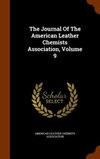Antibacterial Properties of Several Lichen Extracts against Two Moderately Halophilic Bacteria from Salted Sheepskins
IF 0.5
4区 工程技术
Q4 CHEMISTRY, APPLIED
Journal of The American Leather Chemists Association
Pub Date : 2022-04-05
DOI:10.34314/jalca.v117i4.4898
引用次数: 1
Abstract
It is well known that possible undesirable defects in finished leathers can result from microbial activities on the salted raw hides/skins during storage. The traditionally used salt curing method can control bacterial activities on the raw stock, but it does not seem possible to completely eliminate microbial attacks. Moderately halophilic bacteria can cause serious damage to hides/skins. From this point of view, potential procedures such as applying new antibacterialagents in the leather industry should be considered. Since some lichen species have been indicated for their promising biological efficacies in the literature; most researchers have focused on their potencies in various fields including leather industry from ancient times. In this study, the bacterial growth of proteolytic and lipolytic Gram-negative moderately halophilic bacteria, Chromohalobacter canadensis (YN6) and Halomonas eurihalina (BL5), from saltedsheepskin samples were tested with the extracts of Usnea sp., Plastismatia glauca, Ramalina farinacea, Evernia divaricata, Bryoria capillaris, Hypogymnia tubulosa, Pseudevernia furfuracea and Lobaria pulmonaria. Some of these lichen species were found to be successful to inhibit the bacterial growth of C. canadensis (YN6) and H. eurihalina (BL5). In conclusion, lichen extracts may be utilized in stacked raw hides/skins in tanneries or warehouses to control moderately halophilic bacteria which causes several defects on leather.几种地衣提取物对盐渍羊皮中两种中度嗜盐细菌的抑菌性能
众所周知,成品皮革中可能出现的不良缺陷可能是由于储存过程中盐渍生皮革/皮肤上的微生物活动造成的。传统的盐腌方法可以控制原料上的细菌活性,但似乎不可能完全消除微生物的攻击。中度嗜盐细菌会对皮革/皮肤造成严重损害。从这个角度来看,应该考虑在皮革工业中应用新的抗菌剂等潜在的程序。由于一些地衣物种在文献中已被指出具有良好的生物功效;从古代开始,包括皮革工业在内,大部分研究人员都在关注其在各个领域的潜力。本研究以盐渍羊皮样品为原料,用Usnea sp.、Plastismatia glauca、Ramalina farinacea、Evernia divaricata、Bryoria capillaris、Hypogymnia tubulosa、Pseudevernia furfuracea和Lobaria pulmonaria的提取物检测了水解蛋白菌和溶脂菌革兰氏阴性中等嗜盐菌加拿大嗜盐菌(Chromohalobacter canada, YN6)和eurihalina Halomonas eurihalina (BL5)的细菌生长情况。其中部分地衣能有效抑制C. canadensis (YN6)和H. eurihalina (BL5)的生长。综上所述,地衣提取物可用于制革厂或仓库中堆放的生皮/皮肤,以控制导致皮革上几种缺陷的中度嗜盐细菌。
本文章由计算机程序翻译,如有差异,请以英文原文为准。
求助全文
约1分钟内获得全文
求助全文
来源期刊

Journal of The American Leather Chemists Association
工程技术-材料科学:纺织
CiteScore
1.30
自引率
33.30%
发文量
29
审稿时长
3 months
期刊介绍:
The Journal of the American Leather Chemists Association publishes manuscripts on all aspects of leather science, engineering, technology, and economics, and will consider related subjects that address concerns of the industry. Examples: hide/skin quality or utilization, leather production methods/equipment, tanning materials/leather chemicals, new and improved leathers, collagen studies, leather by-products, impacts of changes in leather products industries, process efficiency, sustainability, regulatory, safety, environmental, tannery waste management and industry economics.
 求助内容:
求助内容: 应助结果提醒方式:
应助结果提醒方式:


